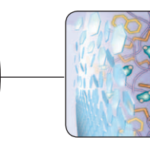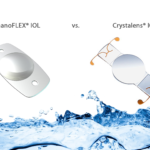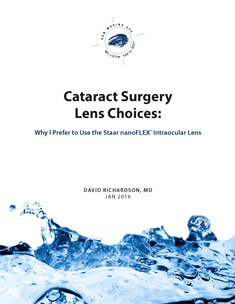As many of you who have been reading my blog know, I like to create series of posts based on a particular theme. I’ve been getting quite a few requests for an update on the IOLs in development so thought this would be a good time to review what’s in the works as well as the latest news about what is currently available in the US. Today’s post will be a brief summary of advanced IOLs. I will discuss each of these IOLs in more detail (in no particular order) over the next few weeks.
Modern eye surgery has changed the way people look at heavy-rimmed glasses and contact lenses. It has been possible for decades to replace the natural lens with a synthetic intraocular lens (IOL). Unfortunately, most people with IOLs still needed glasses after surgery. However, newer advanced intraocular lens implants can restore and maintain clear vision even without glasses and with little risk of developing complications.
Existing IOLs in the market help the eye see images at different distances. Multifocal lenses (ReSTOR®, ReZoom®, Tecnis®) are able to focus near and distant images while accommodating lenses are currently limited to distance and midrange images. These latter lenses increase the eye’s focusing ability (accommodation) by shifting the position (Crystalens®, Tetraflex® and Akkomodative 1CU) or shape (Nulens®, FluidVision Lens, HumanOptics’ Superior Accommodating Lens) of the lens. Of particular note to my US readers is the Synchrony IOL (pictured) as it is most likely the next presbyopia-correcting IOL to be approved in the US.
With all of those choices, it’s not always easy choosing the one that is best for you. Some eye surgeons will “mix and match” different lenses to optimize near vision without compromising distant vision. For example, they may use a multifocal IOL in one eye for near vision (e.g. reading papers) and an accommodating IOL in the other eye for stronger midrange vision (e.g. web browsing or reading price tags).
The additional range of vision, however, comes at a price. IOLs are expensive (and don’t expect your insurance to pick up the cost). In addition to the basic fees for cataract surgery, expect to pay anywhere from $1,500 to $2,800 per eye, depending on the surgeon and the IOL used.
Both those with cataracts as well as those who simply have an ”aging lens” (presbyopia) may profit from these newer IOLs. Experts agree that up to 92% of patients achieve better vision without glasses after the procedure and can sustain good vision even years after lens replacement.
As newer IOLs function in different ways, it is important that the choice of IOL be customized to the individual patient. Patients should discuss each lens option and discuss their important lifestyle needs with their surgeon. Only then can your surgeon pick the best lens for you.
References:
- Vukich J. New Accomodating IOLs. Advanced Ovular Care 2010.
- Schor C, et al. Adaptive Collaboration of Dynamic Accomodation—Implications for Accomodating Intraocular Lenses. J Refract Surg 2008;24:984-990.
- Saiki M, et al. Biconvex posterior chamber accommodating intraocular lens implantation after cataract surgery: long-term outcomes. J Cataract Refract Surg 2010;36:603-608.
- Intraocular lens implants editorial. BMJ 2000;320:73-74.








What is the best U.S. available IOL for 70 year old man with severe astigmatism and presbyopia now wearing tri-focals and on Coumadin for artificial aortic valve? Would the new European lens be better? Why? Is it available in Canada?
Currently, there is no multifocal or pseudo-accommodating IOL available in the US that also corrects astigmatism. It is possible to combine advanced IOLs with astigmatic LASIK correction but even that has limits. Currently, Europe has the broadest selection of IOLs that have been put through a “certification” process. Don’t know if they are available in Canada yet, but it will be awhile before we see these “combination” IOLs in the USA.
Here it is, 2 1/2 years later and we have the Trulign IOL, the first toric presbyopic intraocular lens approved in the United States. Is it too soon to ask about cataract surgery results with this lens?
Would it be possible or beneficial to use the Visian ICL along with a pseudo-phakic IOL, so the Visian can correct for astigmatism or other needs above what the replacement lens can do?
That is an out-of-the box idea that I believe could potentially work. There would be, however, one very large downside: cost. The fee for placement of a Visian ICL is generally in the range of $5,000-8,000. Compared to LASIK ($2,000-5,000) it would not make financial sense for someone to choose and ICL over corneal refractive surgery for residual astigmatism or refractive error after cataract surgery.
[…] follows the insertion of the artificial lens implant — known as an intraocular lens (IOL) — into the empty capsule. The surgeon adds more protective gel to the eye and then folds and slips […]
Aspheric iols in rop + small pupil eye I am 43 years old, I am a complicated cataract case, I was born with r.o.p. nystagmus, a small eye with shallow anterior chamber and short bulb. The working area of my retina is limited to a peripheral side portion. Because of an uveitis I have a seclusio pupillaris due to posterior synechiae. An iridectomy had been performed in order to decrease I.O.P. I was wondering whether an aspheric iol could be a better choice compared to a standard spheric iol because the power of an aspheric lens is constant in both… Read more »
The choice of aspheric vs. spherical IOL will not make much of a difference with peripheral vision. The benefit of an aspheric IOL is really limited to central vision.
The choice of aspheric vs. spherical IOL will not make much of a difference with peripheral vision. The benefit of an aspheric IOL is really limited to central vision.